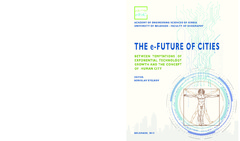Приказ основних података о документу
Demographic Change as Opportunity or Constraint for Technological Development and Economic Growth in Cities of Serbia
| dc.creator | Pantić, Marijana | |
| dc.creator | Živanović Miljković, Jelena | |
| dc.creator | Gajić, Aleksandra | |
| dc.date.accessioned | 2019-11-08T13:56:38Z | |
| dc.date.available | 2019-11-08T13:56:38Z | |
| dc.date.issued | 2019 | |
| dc.identifier.isbn | 978-86-6283-084-5 | |
| dc.identifier.uri | https://raumplan.iaus.ac.rs/handle/123456789/521 | |
| dc.description.abstract | Demographic change, technological development and economic growth are seen in the group of the largest global challenges nowadays. Even though it might not be intentional, they are interconnected and play role of cause and consequence for each other. The nexus between demographics and technology and their interactions have the power to stimulate or to hinder growth, therefore the question what features demographic structure should have in order to push technology and economy forward is relevant to answer. Since the time known to humanity, global population increases. The increase has been also growing, meaning that humanity needed less and less time to reach additional billion – the 2 billionth, 3 billionth, 4 billionth, 5 billionth, and the 6 billionth took 123, 33, 14, 13, and 12 years, respectively. But, for the 7 billionth the humanity took 13 years, in addition to an estimation that the total population of the Earth will stop growing within the lifespan of people who live today. In addition, OECD estimates that there is going to be 51 elderly per 100 individuals of working age, which is only one among arguments proving another aspect of demographic change – aging population. This paper aims at better understating of relations between demography, technology and economy in urban context of Serbia. Statistical data at the level of cities, as they are defined by the Law on Territorial Organization of the Republic of Serbia (2007), are analysed regarding all three aspects, including depopulation, population aging, education structure, working population capacity, employment in technology, etc. The analysed sections of data are interpreted in mutual correlation, thus indicating features of demographic change and their expected outcomes in technology and economics. | en |
| dc.language.iso | en | sr |
| dc.publisher | Belgrade : Academy of Engineering Sciences of Serbia | sr |
| dc.publisher | Belgrade : University of Belgrade - Faculty of Geography | sr |
| dc.relation | info:eu-repo/grantAgreement/MESTD/Technological Development (TD or TR)/36036/RS// | sr |
| dc.relation | info:eu-repo/grantAgreement/MESTD/Integrated and Interdisciplinary Research (IIR or III)/47014/RS// | sr |
| dc.rights | openAccess | sr |
| dc.source | International Scientific Conference: e-Future of Cities, 24-24 October 2019, Belgrade, Serbia | sr |
| dc.subject | demographic change | sr |
| dc.subject | demografske promene | sr |
| dc.subject | technological development | sr |
| dc.subject | tehnološki razvoj | sr |
| dc.subject | economic growth | sr |
| dc.subject | ekonomski rast | sr |
| dc.subject | future of cities | sr |
| dc.subject | budućnost gradova | sr |
| dc.subject | Serbia | sr |
| dc.subject | Srbija | sr |
| dc.title | Demographic Change as Opportunity or Constraint for Technological Development and Economic Growth in Cities of Serbia | en |
| dc.type | conferenceObject | sr |
| dc.rights.license | ARR | sr |
| dcterms.abstract | Пантић, Маријана; Гајић, Aлександра; Живановић Миљковић, Јелена; | |
| dc.citation.spage | 391 | |
| dc.citation.epage | 404 | |
| dc.citation.rank | M33 | |
| dc.description.other | Editor: Borislav Stojkov | sr |
| dc.identifier.fulltext | https://raumplan.iaus.ac.rs/bitstream/id/2262/e_FoC_Pantic_Zivanovic_Miljkovic_Gajic.pdf | |
| dc.identifier.rcub | https://hdl.handle.net/21.15107/rcub_raumplan_521 | |
| dc.type.version | publishedVersion | sr |

